wheel RENAULT KANGOO 1997 KC / 1.G Chassis Service Manual
[x] Cancel search | Manufacturer: RENAULT, Model Year: 1997, Model line: KANGOO, Model: RENAULT KANGOO 1997 KC / 1.GPages: 105
Page 78 of 105
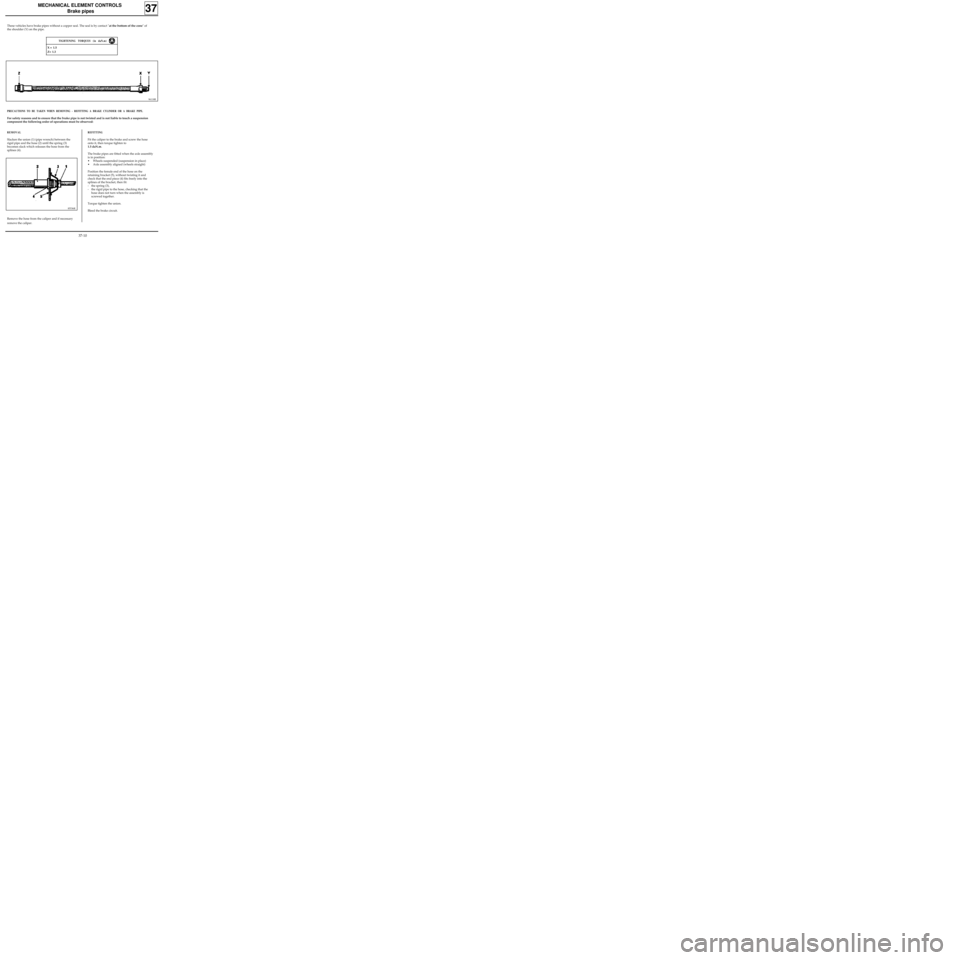
96118R
MECHANICAL ELEMENT CONTROLS
Brake pipes
37
These vehicles have brake pipes without a copper seal. The seal is by contact "at the bottom of the cone" of
the shoulder (Y) on the pipe.
X = 1.5
Z= 1.3
TIGHTENING TORQUES (in daN.m)
PRECAUTIONS TO BE TAKEN WHEN REMOVING - REFITTING A BRAKE CYLINDER OR A BRAKE PIPE.
For safety reasons and to ensure that the brake pipe is not twisted and is not liable to touch a suspension
component the following order of operations must be observed:
Remove the hose from the caliper and if necessary
remove the caliper.
REMOVAL
Slacken the union (1) (pipe wrench) between the
rigid pipe and the hose (2) until the spring (3)
becomes slack which releases the hose from the
splines (4).
85536R
REFITTING
Fit the caliper to the brake and screw the hose
onto it, then torque tighten to
1.5 daN.m.
The brake pipes are fitted when the axle assembly
is in position:
• Wheels suspended (suspension in place)
• Axle assembly aligned (wheels straight)
Position the female end of the hose on the
retaining bracket (5), without twisting it and
check that the end piece (4) fits freely into the
splines of the bracket, then fit:
- the spring (3),
- the rigid pipe to the hose, checking that the
hose does not turn when the assembly is
screwed together.
Torque tighten the union.
Bleed the brake circuit.
37-10
Page 79 of 105

MECHANICAL ELEMENT CONTROLS
Braking compensator
37
CHECKING PRINCIPLE
These vehicle are fitted with a load sensitive
braking compensator.
The pressure is read in an X pattern, by comparing
the pressure at the rear wheels with a given
pressure at the front wheels.
The dual compensator has two totally separate
bodies which act in an X pattern on one front
wheel and one rear wheel.
Both circuits must be checked.
I: front right/ rear left.
II : front left/ rear right.
Load sensitive compensators
For load sensitive compensators, the adjustment
allows alteration of the rear pressure depending
on the front pressure.
The adjustment is made simultaneously in both
bodies. If the pressure is incorrect for one of the
two bodies, replace the compensator.
85925S
37-11
Page 80 of 105
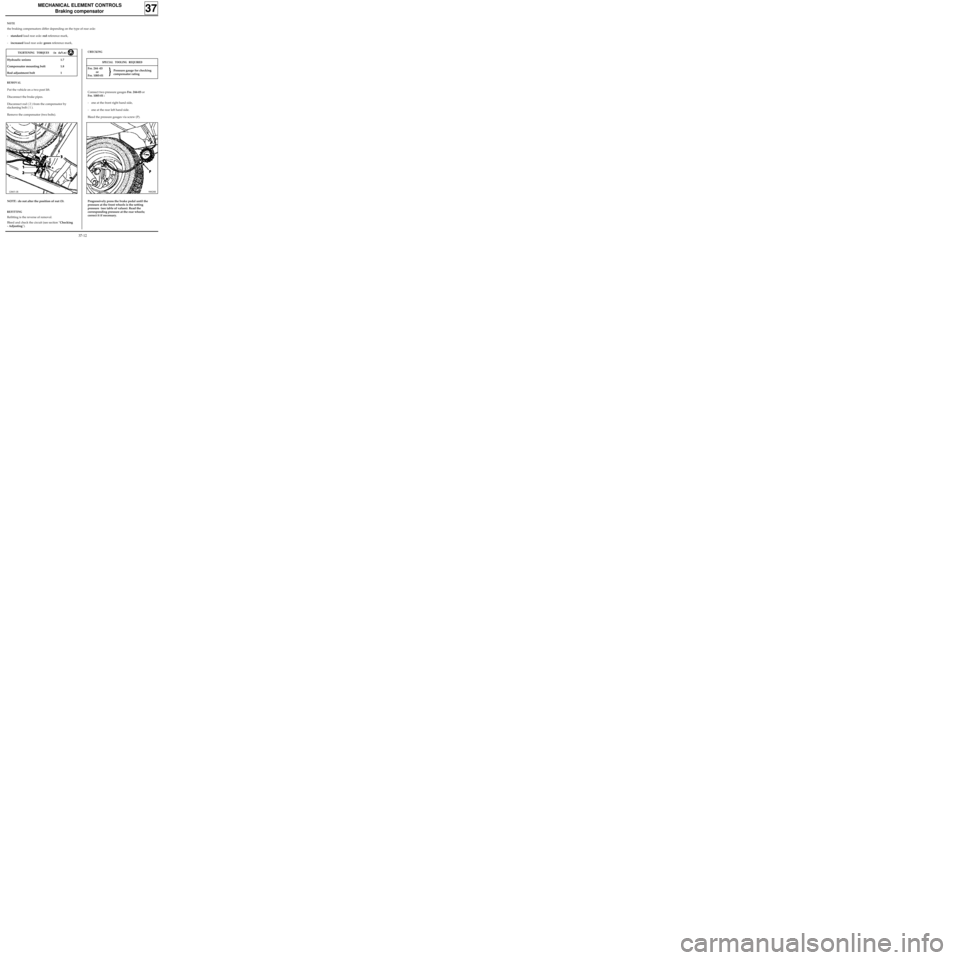
MECHANICAL ELEMENT CONTROLS
Braking compensator
37
NOTE
the braking compensators differ depending on the type of rear axle:
-standard load rear axle: red reference mark,
-increased load rear axle: green reference mark,
REMOVAL
Put the vehicle on a two post lift.
Disconnect the brake pipes.
Disconnect rod ( 2 ) from the compensator by
slackening bolt ( 1 ).
Remove the compensator (two bolts).
12865-1R
TIGHTENING TORQUES (in daN.m)
Hydraulic unions 1.7
Compensator mounting bolt 1.8
Rod adjustment bolt 1
NOTE : do not alter the position of nut (3).
REFITTING
Refitting is the reverse of removal.
Bleed and check the circuit (see section "Checking
- Adjusting").
SPECIAL TOOLING REQUIRED
Fre. 244 -03
or
Fre. 1085-01
CHECKING
Connect two pressure gauges Fre. 244-03 or
Fre. 1085-01 :
- one at the front right hand side,
- one at the rear left hand side.
Bleed the pressure gauges via screw (P).
98828R
Progressively press the brake pedal until the
pressure at the front wheels is the setting
pressure (see table of values). Read the
corresponding pressure at the rear wheels;
correct it if necessary.Pressure gauge for checking
compensator rating
37-12
Page 81 of 105
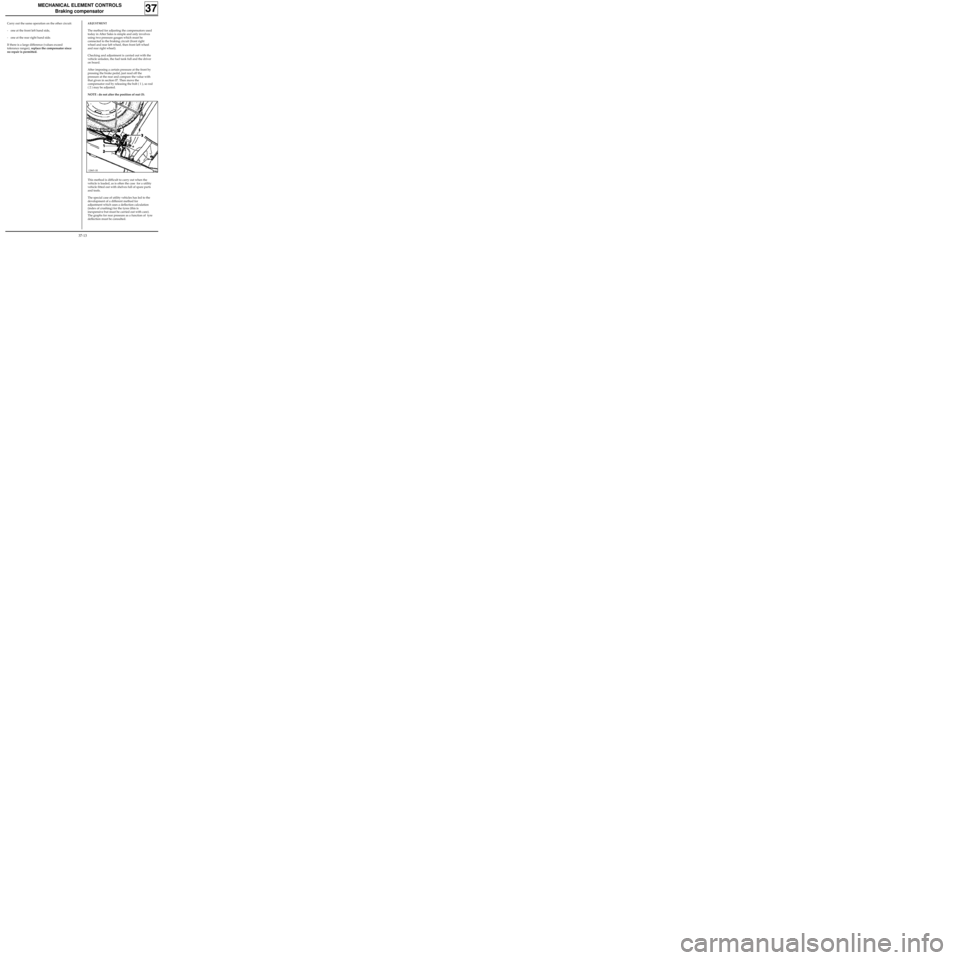
12865-1R
MECHANICAL ELEMENT CONTROLS
Braking compensator
37
Carry out the same operation on the other circuit:
- one at the front left hand side,
- one at the rear right hand side.
If there is a large difference (values exceed
tolerance ranges), replace the compensator since
no repair is permitted.ADJUSTMENT
The method for adjusting the compensators used
today in After Sales is simple and only involves
using two pressure gauges which must be
connected to the braking circuit (front right
wheel and rear left wheel, then front left wheel
and rear right wheel).
Checking and adjustment is carried out with the
vehicle unladen, the fuel tank full and the driver
on board.
After imposing a certain pressure at the front by
pressing the brake pedal, just read off the
pressure at the rear and compare the value with
that given in section 07. Then move the
compensator rod by releasing the bolt ( 1 ), so rod
( 2 ) may be adjusted.
NOTE : do not alter the position of nut (3).
This method is difficult to carry out when the
vehicle is loaded, as is often the case for a utility
vehicle fitted out with shelves full of spare parts
and tools.
The special case of utility vehicles has led to the
development of a different method for
adjustment which uses a deflection calculation
(index of crushing) for the tyres (this is
inexpensive but must be carried out with care).
The graphs for rear pressure as a function of tyre
deflection must be consulted.
37-13
Page 82 of 105
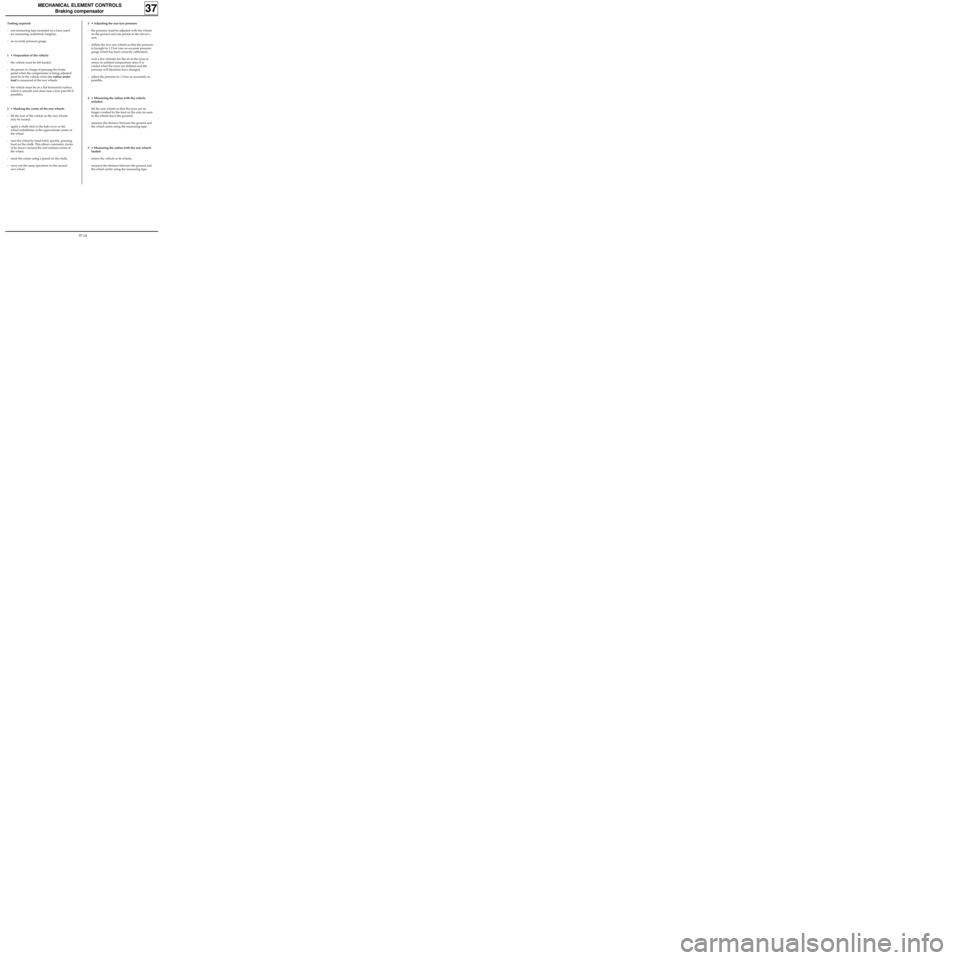
MECHANICAL ELEMENT CONTROLS
Braking compensator
37
Tooling required:
- one measuring tape mounted on a base (used
for measuring underbody heights),
- an accurate pressure gauge.
1• Preparation of the vehicle:
- the vehicle must be left loaded,
- the person in charge of pressing the brake
pedal when the compensator is being adjusted
must be in the vehicle when the radius under
load is measured at the rear wheels,
- the vehicle must be on a flat horizontal surface,
which is smooth and clean (use a four post lift if
possible).
2• Marking the centre of the rear wheels:
- lift the rear of the vehicle so the rear wheels
may be turned,
- apply a chalk stick to the hub cover or the
wheel embellisher at the approximate centre of
the wheel,
- turn the wheel by hand fairly quickly, pressing
hard on the chalk. This allows concentric circles
to be drawn around the real rotation centre of
the wheel,
- mark the centre using a pencil on the chalk,
- carry out the same operation on the second
rear wheel.3• Adjusting the rear tyre pressure:
- the pressure must be adjusted with the wheels
on the ground and one person in the driver’s
seat,
- deflate the two rear wheels so that the pressure
is brought to 1.2 bar (use an accurate pressure
gauge which has been correctly calibrated),
- wait a few minutes for the air in the tyres to
return to ambient temperature since it is
cooled when the tyres are deflated and the
pressure will therefore have changed,
- adjust the pressure to 1.2 bar as accurately as
possible.
4• Measuring the radius with the vehicle
unladen:
- lift the rear wheels so that the tyres are no
longer crushed by the load on the axle (as soon
as the wheels leave the ground),
- measure the distance between the ground and
the wheel centre using the measuring tape.
5• Measuring the radius with the rear wheels
loaded:
- return the vehicle to its wheels,
- measure the distance between the ground and
the wheel centre using the measuring tape.
37-14
Page 83 of 105
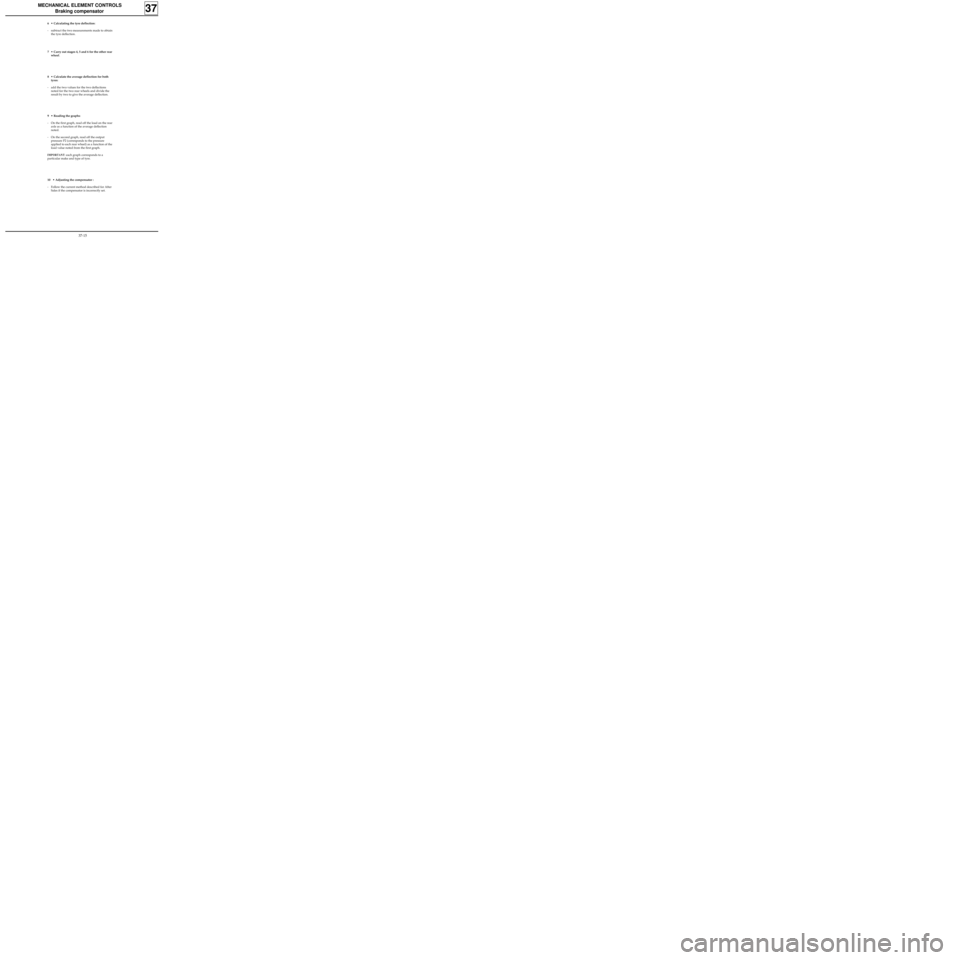
MECHANICAL ELEMENT CONTROLS
Braking compensator
37
6• Calculating the tyre deflection:
- subtract the two measurements made to obtain
the tyre deflection.
7• Carry out stages 4, 5 and 6 for the other rear
wheel.
8• Calculate the average deflection for both
tyres:
- add the two values for the two deflections
noted for the two rear wheels and divide the
result by two to give the average deflection.
9• Reading the graphs:
- On the first graph, read off the load on the rear
axle as a function of the average deflection
noted.
- On the second graph, read off the output
pressure P2 (corresponds to the pressure
applied to each rear wheel) as a function of the
load value noted from the first graph.
IMPORTANT: each graph corresponds to a
particular make and type of tyre.
10 • Adjusting the compensator :
- Follow the current method described for After
Sales if the compensator is incorrectly set.
37-15
Page 96 of 105
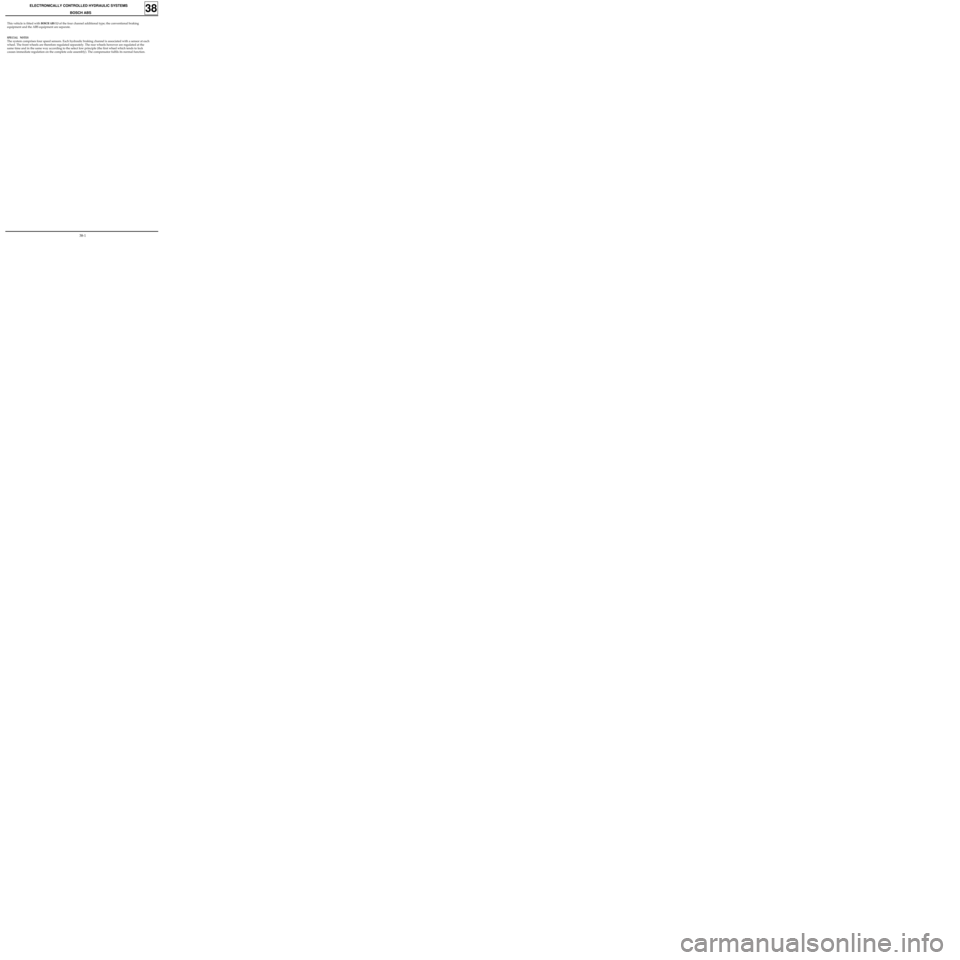
ELECTRONICALLY CONTROLLED HYDRAULIC SYSTEMS
BOSCH ABS
38
This vehicle is fitted with BOSCH ABS 5.3 of the four channel additional type; the conventional braking
equipment and the ABS equipment are separate.
SPECIAL NOTES
The system comprises four speed sensors. Each hydraulic braking channel is associated with a sensor at each
wheel. The front wheels are therefore regulated separately. The rear wheels however are regulated at the
same time and in the same way according to the select low principle (the first wheel which tends to lock
causes immediate regulation on the complete axle assembly). The compensator fulfils its normal function.
38-1
Page 98 of 105
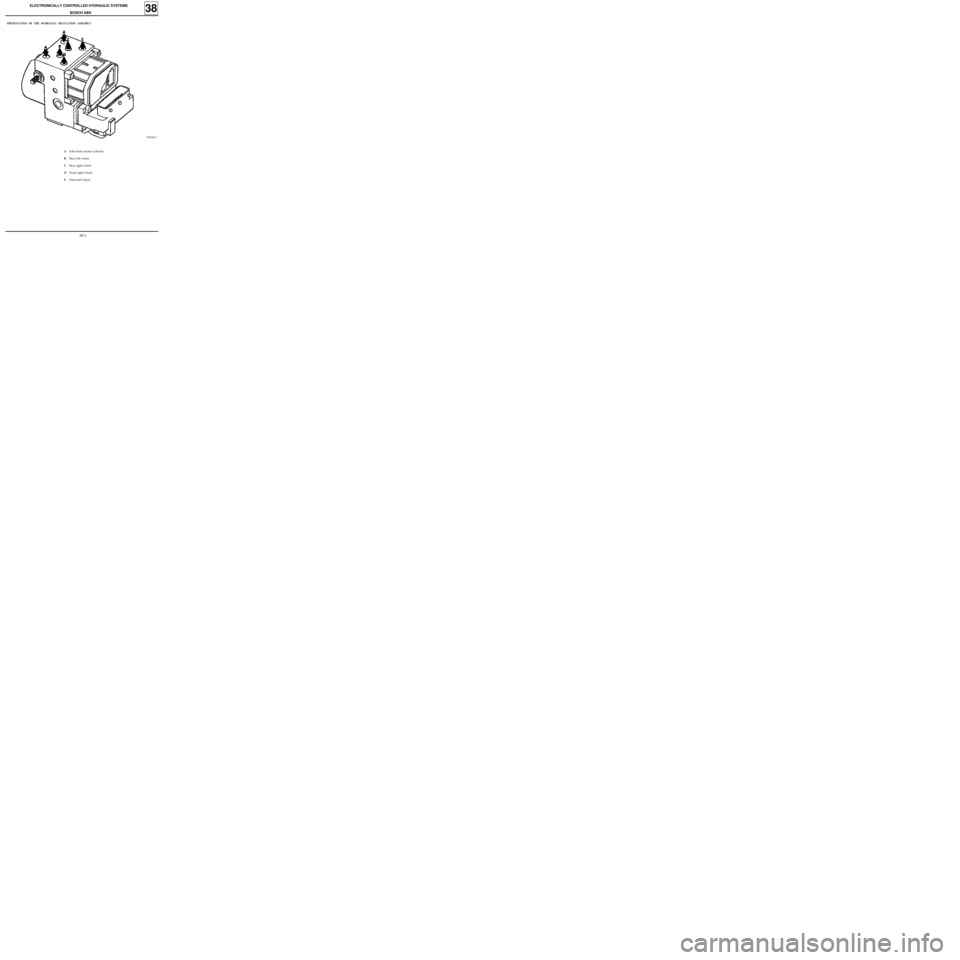
PRN3819
PRESENTATION OF THE HYDRAULIC REGULATION ASSEMBLY
AInlet from master cylinder
BRear left wheel
CRear right wheel
DFront right wheel
EFront left wheel
ELECTRONICALLY CONTROLLED HYDRAULIC SYSTEMS
BOSCH ABS
38
38-3
Page 100 of 105

WIRING DIAGRAM KEY
104Ignition switch
118 ABS computer
150Rear right wheel sensor
151Rear left wheel sensor
152Front right wheel sensor
153Front left wheel sensor
160Stop switch
225Diagnostic socket
247Instrument panel
260Fuse box
777Power feed fuse board
R2Dashboard / rear left
R36ABS / Dashboard
R101Right hand side member / Right hand
headlight
ELECTRONICALLY CONTROLLED HYDRAULIC SYSTEMS
BOSCH ABS
38
38-5
Page 103 of 105
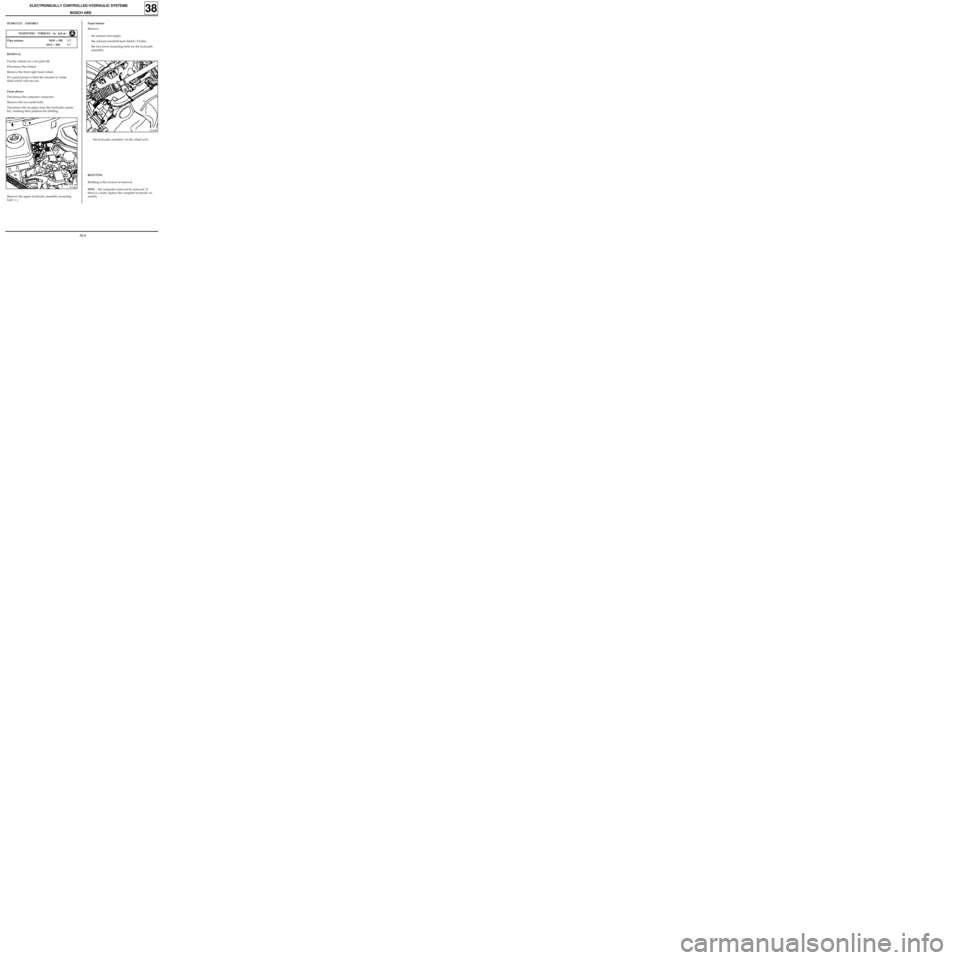
ELECTRONICALLY CONTROLLED HYDRAULIC SYSTEMS
BOSCH ABS
38
13138R
Pipe unions M10 × 100 1.7
M12 × 100 1.7
TIGHTENING TORQUES (in daN.m)
REMOVAL
Put the vehicle on a two post lift.
Disconnect the battery.
Remove the front right hand wheel.
Fit a pedal press to limit the amount of brake
fluid which will run out.
From above:
Disconnect the computer connector.
Remove the two earth bolts.
Disconnect the six pipes from the hydraulic assem-
bly, marking their position for refitting.
From below:
Remove:
- the exhaust downpipe,
- the exhaust manifold heat shield ( 3 bolts),
- the two lower mounting bolts for the hydraulic
assembly,HYDRAULIC ASSEMBLY
13139R
- the hydraulic assembly via the wheel arch.
Remove the upper hydraulic assembly mounting
bolt ( 1 ).
REFITTING
Refitting is the reverse of removal.
NOTE : the computer must not be removed. If
there is a fault, replace the complete hydraulic as-
sembly.
38-8